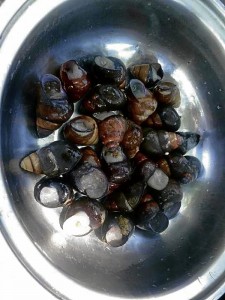
BUSH SNAILS, locally known as takyong, can be prepared in many different ways. They can be fried, grilled or stewed.
BORBON, Cebu—Cebu has an answer to the French escargot.
The “takyong,” the lowly bush snails endemic in Borbon town in northern Cebu, not only taste good but are also believed to have aphrodisiac properties and can be used as home remedy for asthma.
Living and feeding on the barks of indigenous tree species, such as jackfruit, the snails are readily available and have become the food of the town’s poorest of the poor. These are fried, grilled and stewed, and can substitute for “sisig” or can be served with beer.
It was only last year, however, that the takyong become popular after the Obra Negosyo Eskwela, a project of the provincial government and the Mandaue Chamber of Commerce and Industry (MCCI).
The project was actually a competition among students from different universities to submit the best business plan for a particular town. The participants were mentored by MCCI members.
Each school partnered with a Cebu town, and the students must find out the town’s business potentials and submit a business proposal.
UP students
Students of the University of the Philippines College Cebu saw the business potential of takyong in Borbon, their partner and a fourth-class municipality (annual income: P25 million-P35 million) 82 kilometers north of Cebu City.
With MCCI trustees Girlie Garces and Vicky Dy, they met with the local officials to explore the snails’ revenue potential, according to Lerbin Antigua, municipal planning and development coordinator.
The first business plan called for the production of bottled takyong. Each bottle is now being sold for P150 in stores within the town of Borbon,
But “during the course of the study, it was discovered that takyong is an endangered species. Because of that, our project took on a diversified approach,” says Garces, who is also business affairs and communications officer of San Miguel Corp.
Unfortunately, the takyong project did not win the competition, but Garces said the partnership with Borbon continued.
In December last year, UP came out with a paper suggesting that municipal officials approve an ordinance prohibiting the sale of takyong outside Borbon to protect the endangered species. It also recommended that the town go into snail farming by establishing takyong sanctuaries to propagate the snails.
No outside sale
The municipal government responded by passing the ordinance in February. “We made sure that we protect what we have. We don’t allow people to take live takyong outside of Borbon, especially that they are now popular,” says Mayor Bernard Sepulveda.
Initially, Borbon invested P5,000 to establish the takyong sanctuaries in its 19 barangays. The biggest village, Cajil, serves as the “bagsakan” (trading center) where the snail is sold at P1 apiece.
According to Antigua, the muncipal officer, takyong is harvested from the sanctuaries alternately. For instance, the snails are taken from April to June in three sanctuaries and for the next three months, in another cluster. “This is done to ensure that what was harvested is replenished,” she says.
An entrepreneur, Grace Montegrande, does the bottling under the brand name, “Grace Bottled Takyong,” in Barangay Logo. One bottle contains 23 pieces of takyong. In a week, 100 bottles can be produced at P150 each.
The MCCI’s Garces says the chamber was supporting the planting of indigenous trees, the takyong habitat, in Borbon. A colleague, who is also a marketing director of the advertising firm, AdNetwork Corp, is helping the town prepare an eco-tourism map, highlighting the takyong sanctuaries.
Efforts to market the snails have yet to go full-blast, but demand is already high. Tourists always drop by the stores to buy bottled takyong, according to Antigua.
photos by Cris Evert B. Lato, Borbon, Cebu